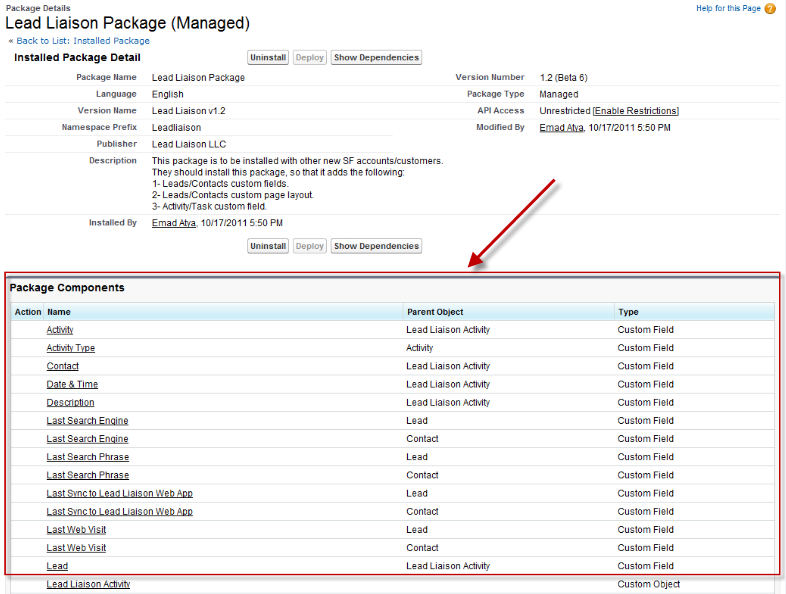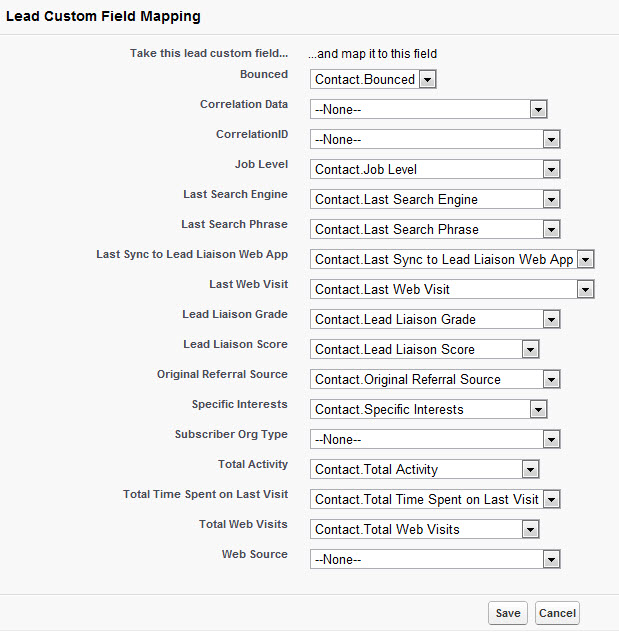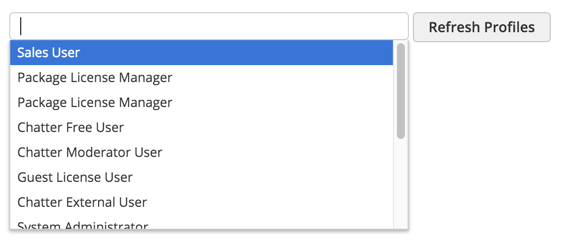| Info |
|---|
This document explains the steps required to connect Lead Liaison with your Salesforce.com Professional, Enterprise or Unlimited Edition account. |
| Table of Contents |
|---|
Installation Overview
Lead Liaison is installed into Salesforce.com in a few easy steps. Here's an overview of the installation process:
- Setup a CRM sync user by adding your CRM credentials into Lead Liaison.
- Install Lead Liaison's Salesforce.com package through Salesforce.com's AppExchange.
- Add fields into your Salesforce.com Lead and Contact Layouts.
- Setup Lead <> Contact field mappings in Salesforce.com.
- Use Lead Liaison's CRM configuration wizard and sync your Salesforce.com data to Lead Liaison.
Lead Liaison's Salesforce.com package will make the following changes to your Salesforce.com account:
...
Connect Salesforce.com to Lead Liaison
Follow these step by step instructions to connect your Salesforce.com account to Lead Liaison.
Step 1: Add CRM Sync User
Lead Liaison requires one Salesforce.com user account be used as a master sync account. The sync account is the account used to send data bidirectionally, from Salesforce.com to Lead Liaison and from Lead Liaison to Salesforce.com. The sync account is required for operation and has no material impact on leads, contacts, opportunities or any other event.
| Note |
|---|
Salesforce.com suggests updating passwords every 90 days. If credentials for the sync account expire then syncing between Lead Liaison and Salesforce.com will fail. We suggest using a Salesforce.com Admin user as the sync account to use with Lead Liaison. See the section below called "Salesforce.com Password Profiles" for tips on how to set the password to never expire on your Salesforce.com user account. |
Follow the steps below to enter your CRM sync user:
...
Step 2: Install Lead Liaison's Plugin into Salesforce.com
Install URL
Lead Liaison's Salesforce.com plugin is live on Salesforce's AppExchange portal. Access the plugin here: http://appexchange.salesforce.com/listingDetail?listingId=a0N30000009vFlTEAU
...
Follow the instructions below:
- After install, and to view the package contents at a later point show all installed package contents under 'Setup' > 'Installed Packages'.
- Proceed to Step 3 to integrate Lead Liaison into your layout.
Step 3: Add Lead Liaison's Custom Fields/Sections to your Salesforce.com Layout
| Info | ||
|---|---|---|
| ||
If you have the Enterprise or Unlimited Edition of Salesforce.com then it is optional to add these two sections. If you have the Professional Edition or Group Edition then you must add the Lead Liaison Marketing Data section to your Lead/Contact layout; however, the Lead Liaison section is optional. |
During this step you will add two sections, "Lead Liaison Marketing Data" and "Lead Liaison", to the Lead and Contact layouts.
- Open the Leads page layout by going to 'Setup' > 'Customize' > 'Leads' > 'Page Layouts'.
- Click the 'Edit' link next to the Salesforce.com layout you'd like to add Lead Liaison's custom fields/sections to.
- You will see a page similar to the one below.
...
Step 4: Map Lead Custom Fields to Contact Custom Fields
Next, map the custom fields added by the Lead Liaison plug-in. Mapping custom fields ensures information added to a Lead is transferred to a Contact when the lead is converted in Salesforce.com. To map fields do the following:
- Go to 'Setup' > 'Customize' > 'Leads' > 'Fields'.
- Scroll to the bottom and click the "Map Lead Fields" button in the "Lead Custom Fields & Relationships" section.
- Map each custom Lead field to the related Contact field. Your results should look similar to the image below:
| Info | ||
|---|---|---|
| ||
Make sure to map all the custom fields added by Lead Liaison package (Lead Liaison Score, Total Activity, Total Web Visits, Total time spent on last visit, Last Sync to Lead Liaison Web App, Last Web Visit, Last Search Engine, Last Search Phrase, Original Referral Source, Bounced and Profile Identifier) |
| Info | ||
|---|---|---|
| ||
Map only the "Profile Identifier" field. Do not map the "Profile ID" field. Lead Liaison adds the Profile Identifier field automatically. This field is a formula that builds the hyperlink for the Profile ID. By mapping the Profile Identifier Salesforce.com will automatically map the Profile ID value for you. |
...
| Note | ||
|---|---|---|
| ||
This section is not required for Group or Professional Editions of Salesforce.com. |
To allow Lead Liaison's software to view and interact with certain Salesforce.com fields visibility permissions must be changed for each field listed below under the respective object. Five (5) objects contain fields that need updated visibility permissions. The 5 objects are:
- Leads
- Contacts
- Accounts
- Tasks
- Opportunities
- Campaigns (if you're using them)
| Note |
|---|
These settings must be applied only to the profile of the CRM user whose account is used for automatic syncing (see 'Step 1: Add CRM Sync User' section above). |
How to Change Visibility Permissions
...
Complete Lead Liaison's CRM Configuration Wizard:
Lead Liaison synchronizes data between Lead Liaison's local database and Salesforce.com in real-time. To configure your CRM settings for Lead Liaison:
- Login to Lead Liaison at https://app.leadliaison.com/login.php
- Click the Settings > Integrations > CRM
- Follow the wizard step by step to get your CRM account configurations complete
| Info |
|---|
Step 1: Select Edition and Default Sync Options |
...
- Lead Liaison automatically imports all active users from Salesforce.com and creates an equivalent Lead Liaison user for each Salesforce.com user. For larger accounts, or accounts using items like "Profile Users", there might be tens of thousands of users. For this purpose, Lead Liaison provides the ability to sync only user with specific Salesforce.com User Profiles. Select which User Profiles you want to sync with. When the wizard initially loads all existing profiles are pulled in. If new profiles are added, click the "Refresh Profiles" button. Users with Salesforce.com profiles that no longer match User Profiles authorized to sync will get removed.
- The only Salesforce.com standard field that Lead Liaison adds values to is the "Lead Source" field. By default, Lead Liaison's "Original Lead Source" field is mapped to Salesforce.com's "Lead Source" field. If you do not want Lead Liaison's Original Lead Source data to be integrated with the Lead Source field then uncheck the "Deploy Lead Liaison custom Lead Source values" checkbox. If you want to separate Salesforce.com's Lead Source and Lead Liaison's Original Lead Source values do the following:
- Create a new SFDC Lead and Contact Custom field called "Lead Liaison Lead Source"
- Create a new custom field in Lead Liaison called "SFDC Lead Source"
In Lead Liaison change the Lead and Contact field mappings:
Map the SFDC standard field "Lead Source" to the new custom field called "SFDC Lead Source" with bi-directional sync.
Map the new custom field in SFDC, "Lead Liaison Lead Source", to Lead Liaison's "Original Lead Source" field with one-way syncing from Lead Liaison to Salesforce.com.
...
Enable Automatic Lead Creation (optional)
Lead Liaison offers the ability to automatically create a lead in Salesforce.com from visitors to your website that come from Connector (E-mail Marketing solution) or Send & Track (Microsoft Outlook Plug-in).
- Login to Lead Liaison at https://app.leadliaison.com/login.php
- Click Settings > Setup on the top of the page.
- Under "Admin Settings" section, click 'Account settings'.
- Check the check boxes next to "Auto-create CRM lead from email campaigns" and "Auto-create CRM lead from Send & Track emails" to enable automatic lead creation.
Setup Additional Users
Reference this page.
| Tip |
|---|
Congratulations, you're done! |
SFDC Custom Objects
The integration can include pushing Salesforce.com custom fields into Lead Liaison; however, does not include pushing Salesforce.com custom objects into Lead Liaison. As a workaround, the data from the Salesforce.com custom objects can be configured into a custom report and that report extract can then be imported into Lead Liaison.
...
Removing the Lead Liaison Package
- First, remove all dependencies. Dependencies must be removed first before uninstalling. For example, assigning the Lead Liaison Lead Layout to a profile is a dependency. Change the layout profile to another profile or the standard profile first.
- Inside Salesforce.com go to 'Setup' > 'View Installed Packages'. If there are any dependencies removal will fail.
Alternative Ways to Add Lead Liaison's Sections to Lead/Contact Layouts
...
#1 Assigning Lead Liaison's layout to your profiles
To view the newly created Lead Liaison fields and sections assign the 'Lead Liaison Layout' to each profile which needs to see the data.
- Open the profiles page by going to 'Setup' > 'Administration Setup' > 'Manage Users' > 'Profiles'. In this example, we'll assign the Lead Liaison Layout to the Salesforce.com 'Standard Profile'.
- Click on the 'Standard User' link.
- Under the 'Page Layouts' section under 'Lead' click the 'View Assignment' link.
- Click the 'Edit Assignment' button.
- Next to "Page Layout To Use:" select 'Lead Liaison Lead Layout' and click 'Save'.
- Now you have successfully assigned the Lead Liaison layout to your profile.
- Repeat the same procedure for the Contacts section and assign the 'Lead Liaison Contact Layout' layout to the appropriate profiles.
#2 Automatically during the "Install Package" step of Lead Liaison's Configure CRM wizard
Go to the CRM configuration wizard:
- Click Settings > Integrations > CRM
Begin by selecting your CRM version. You can find your CRM version by hovering your mouse over your browser's tab.
In Step 2 of the CRM Wizard, simply check the box in the "Install Plug-in" section at the bottom of your screen.
| Note |
|---|
This step will add only the Lead Liaison Marketing Data section to your layout. You must manually add the Lead Liaison section (visual force page) to your layout. |




